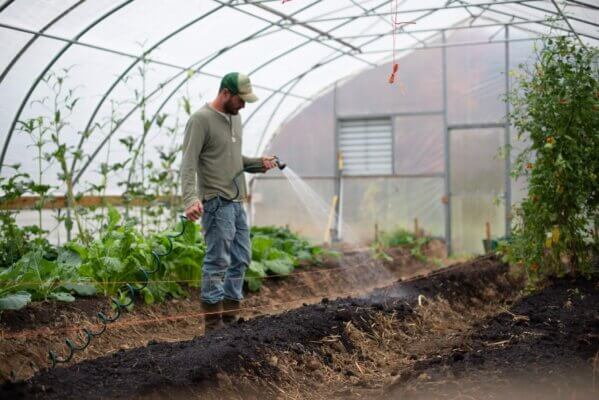
Nearly 20% of Michiganders are employed in the agriculture industry.
Michigan’s agriculture economy is hardly small potatoes. Actually—it’s a lot of potatoes. And cherries. And Asparagus. And grapes too. Have you heard of all of these Michigan food capitals?
MICHIGAN—When it comes to agricultural diversity, Michigan leads the nation—second only to California. We’ve got over 300 different agricultural commodities spread out over 10 million acres of farmland, representing a whopping 17% of our overall state employment.
And that’s not just cherries. Traverse City’s status as the Cherry Capital of the world is known far and wide; but when it comes to other crops, there are plenty of cities and towns across the Mitten that have made a name for themselves and their bountiful harvests.
Here are few worth knowing:
South Haven (Blueberries)

After the lumber industry cleared out swaths of forest land, farmers in South Haven found the remaining land perfect for farming. And the fertile soils and lakeside climate of Michigan’s fruit belt help make South Haven one of the country’s best areas to grow blueberries—so good that Michigan now ranks third in the nation for blueberry production.
Aside from enough blueberry farms to keep you busy all summer, South Haven has also celebrated the National Blueberry Festival every August since 1963—just six short years before South Haven officially acquired the “Blueberry Capital” title. It originally started as a recipe competition but has since expanded into a celebration of everything blueberry, including attractions like free outdoor concerts, parades, and pie-eating contests.
Sparta (Apples)

Michigan ranks third in the country for apple production, with more than 1 billion apples harvested every year from a large number of orchards and cider mills across the state. Sparta doesn’t hold any official distinction as the “Apple Capital” of Michigan, but it certainly has some fruity history that helped lay the foundation for the state’s bustling apple business.
Sparta initially started as a peach-growing area, but apple orchards won out as the top crop in the 50s. In 1957, Sparta grower and former US Army Sgt. Lewis Arends discovered a new variety of the McIntosh apple on his 80-acre farm. It needed a name, and Lewis Arends had the perfect one—the apple of his eye, his wife Pauline. Arends eventually patented the Paula Red apple in the 1960s, which led to thousands of trees planted across the US and Canada.
Unlike other apples that were harvested in mid-to-late September, Paula Reds were ripe for the picking in August—making it a perfect revenue driver in colder climates like Michigan.
Sparta continues to celebrate its agricultural history with the Michigan Apple Fest, an annual September event packed with every type of apple-derived food or beverage imaginable.
Paw Paw (Grapes)

Northwest Michigan is known for its sprawling fields of grapevines. But did you know southwestern Michigan is known for its grapes and wine too? Both regions help Michigan rank eighth in the country for grape production, and fifth in the US for wine production—earning the Mitten the playful moniker of the “Napa of the Midwest.”
Paw Paw is located in the heart of Michigan’s wine country. And though not quite a grape, the town gets its name from a distant cousin in the plant kingdom—the paw paw fruit, which reportedly has a custard-like flavor, somewhat similar to banana, mango and pineapple.
A.B. Jones brought the first vineyard to Van Buren County after being inspired by the profits made in the River Raisin area. Prohibition and grape rot later brought the Monroe-area vineyards to a screeching halt, but the Van Buren County crop survived. One of the region’s winning strategies? Selling grapes to Welch’s to make grape juice during prohibition.
Paw Paw is also home to the state’s oldest, largest and arguably most prestigious winery: St. Julian Winery, which continues to produce award-winning wines from Michigan fruits. Paw Paw’s grape heritage culminates in the Paw Paw Wine and Harvest Festival, a signature event weekend after Labor Day that has been running for more than 30 years.
Hart and Shelby (Asparagus)

No other state produces as much asparagus as Michigan, and Oceana County holds the crown for asparagus production. That’s why two of its towns—Shelby and Hart—have both been labeled as the Asparagus Capital of Michigan. And they’re both winners in our book.
In the early 20th century, canning companies came to Michigan and farmers were looking for an early spring crop that could be easily packaged and shipped around the world. Asparagus provided the solution—and Michigan’s fruit belt provided the perfect growing environment.
In 1974, Oceana County started the National Asparagus Festival, the country’s longest running asparagus celebration, held annually on the second weekend in June. The event runs three days and features a farm tour, parade, and plenty of asparagus tastings.
Posen (Potatoes)

OK: We know. Michigan isn’t quite as famous for potatoes as Idaho. But it’s still our top cash crop, and nowhere else in the state harvests more of them than the small town of Posen.
What Posen lacks in size, it makes up for with its huge Polish heritage—and potatoes are key for Placki Ziemniaczane, also known as potato pancakes, among other Polish dishes.
Like many other farming communities, Posen started as a logging settlement. After the timber supply was exhausted, Polish immigrants bought the land and named it Posen—the German spelling for the Polish Province of Poznan, from where most of them were born.
For seven decades, Posen has also hosted the Posen Potato Festival, which celebrates the history of the Polish potato farmers and their contributions to the state’s agriculture industry.
Mesick (Morel Mushrooms)
Mushrooms are misunderstood. Although we often classify them as a vegetable, these tasty fungi aren’t even in the same kingdom as our garden-variety vegetables. But that doesn’t mean they can’t form an important part of Michigan agriculture—especially in Mesick.
Morel mushrooms are rarely farmed. Instead, they’re mostly found in the wild by mushroom hunters. That means their natural grow sites—like in northern Michigan—are closely coveted by hunters. We don’t know exactly where, but forests near Mesick become a popular destination for mushroom hunters across the state between late April and early June.
The Mesick Mushroom Festival is held annually on Mother’s Day Weekend, and it’s a tradition that has lasted over 60 years. Here, both professional and amateur mushroom hunters alike come together for a meeting of the minds on hunting strategies. And there’s plenty of time for celebrating the culture too, with a parade, car show, carnival, and more.
Saint Johns (Mint)
Personal preferences are split on mint chocolate chip ice cream—but in the city of St. Johns, they make a real mint on the mint. The US makes over 70% of the world’s mint, and Michigan is one of the oldest and most prominent producers of the nation’s spearmint.
As early as the mid-1800s, Michigan was a top contender for the nation’s mint supply and by the 20th century, St. Johns was producing 90% of the world’s supply. Mint oil was in-demand as a medicine and a flavor additive for products such as Wrigley’s chewing gum. The Clinton County area had plenty of mucky soil, which served as perfect mint growing conditions.
The Crosby Mint Farm, established in 1912, claims to be the oldest continuously family-operated mint farm in the country. And St. Johns celebrates its mint heritage every August with the Mint Festival. In addition to all the mint ice cream you could want, the festival features live music, a classic car show, cornhole and kickball tournaments, and much more.
Glenn (Pancakes)
Michigan ranks sixth in the nation for maple-based products, with over 90,000 gallons of maple syrup tapped every year statewide. But instead of any city laying claim to the title of Maple Syrup Capital, one Michigan town has something a bit weirder: The Pancake Capital.
Why pancakes? That answer lies in the history of Glenn.
The town of less than 3,000 residents is located on the scenic US Route 31, which in the 30s was the only road leading to larger cities such as Chicago. In 1937, a monumental snowstorm stranded over 200 motorists in the Glenn. And for three days, the storm raged on as supplies dwindled, leaving only one survival solution: a large shipment of pancake flour.
The stranded motorists ate pancakes for every meal as they waited out the storm, cementing Glenn’s history as the Pancake Capital of Michigan. Even almost a century later, Glenn still celebrates its history every year with a large pancake breakfast to keep the tradition alive.
Kinde (Beans)

Michigan is the nation’s top producer of dried beans, and the state’s top producer is tucked away at the tip-top of the Thumb. It’s the small village of Kinde, Michigan’s Bean Capital.
Kinde is named after founder John Kinde, who helped form the village while Michigan’s economy was transitioning from lumber to agriculture. Kinde’s claim to fame came with white navy beans, which were fed to some of the most prominent politicians across the country.
The US Senate dining room still serves “Senate Bean Soup,” a comfort food made with Kinde’s beans in stock and topped up with onions, ham hocks, and spices. History forgot the original reason why Senate Bean Soup became a hit in DC. But senators from either Idaho or Minnesota were said to have been the first to grow a taste for the Michigan bean soup.
Though not held in Kinde, the Michigan Bean Festival in nearby Fairgrove also celebrates the region’s bean cultivation heritage annually over Labor Day weekend.
Elsie (Dairy)
This small town in the middle of the Mitten has one particularly memorable feature—a bull statue repainted to look like a cow,named after the town she resides in. They call her Elsie.
Michigan ranks sixth in the country for milk production. And although the majority of dairy farms are found in Sanilac and Huron counties, Clinton County and the Dairy Capital of Elsie still lead the herd with its fiberglass mascot, which originally came from a local dairy farm.
Since the 60s, the town has invited visitors from across the state to participate in the annual Elsie Dairy Festival in July, which celebrates the town’s industry history. A second version of the town’s iconic mascot appears in the parade, but that’s not all there is to milk from the festival: the Dairy Festival also features a talent show, pageant, marathon, and more.

VIDEO: Trump isn’t the only republican facing charges for alleged financial crimes
https://www.tiktok.com/@gandernewsroom/video/7361494909938978090 A whole lot of Michigan Republicans and lobbyists are facing criminal charges for...

VIDEO: It’s expensive to be poor in Michigan
https://www.tiktok.com/@gandernewsroom/video/7361154790300060974 Ever heard of predatory payday loans? Here’s how new laws could help protect...

Here’s everything you need to know about this month’s Mercury retrograde
Does everything in your life feel a little more chaotic than usual? Or do you feel like misunderstandings are cropping up more frequently than they...

The ’Gander wins multiple 2023 Michigan Press Association awards
MICHIGAN—The ’Gander Newsroom has earned multiple awards in the 2023 Michigan Press Association Better Newspaper Contest. The awards were announced...

Michigan Republicans ask Supreme Court to restrict medication abortion access
A lawsuit supported by Republicans could disrupt access to the most common form of abortion—even in Michigan, where reproductive rights are...






